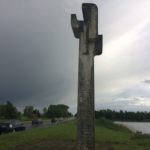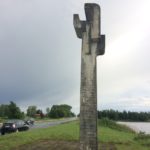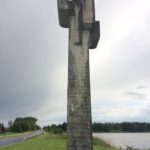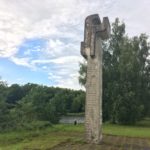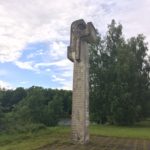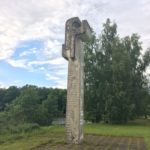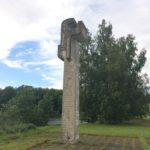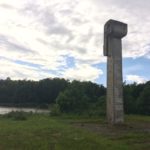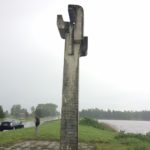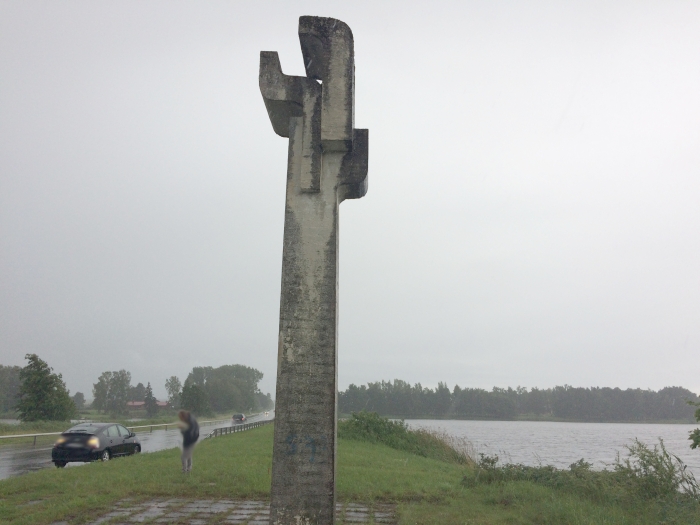
by Geoff Vasil
I entered Kaišiadorys in a pounding rain to see the Soviet monument the local residents want removed.
Visibility was perhaps 10 feet as I passed what seemed to be farmsteads and fields. Up ahead the road bisected a rather beautiful little lake. A weird light enveloped the scene, black clouds on one side and open blue sky on the other, with cattails, a bright green made neon against dark gray.
The monument appeared there on the other side of the lake right by the road, looking for all the world like a broken-down chimney of an abandoned factory, but surrounded by a natural idyll the summer squall was unable to diminish.
The monument itself has no inscription. It might have, once upon a time, but there was no evidence even of a stolen metal plaque, no holes for bolts, no tell-tale metal stains dripping down from an empty space anywhere on its face. The only thing close to an inscription was some faded graffiti, some message left in blue spray-paint but now illegible.
The monument is decidedly not an obelisk. It has four sides, slightly tapers, but its apex is a rather undecipherable combination of swirls and stylization, the sort of Soviet-era statuary which might mean anything to anyone, and therefore means nothing at all. Is it a wrench? Is it a swastika trampled into ruin on top of the chimney?
At the base there are some cement blocks used as pavement, the kind one sees on river embankments, with holes to allow greenery to poke through. A man drove up in an SUV and parked on the shoulder there, watching me intently as if I might be there to steal something. He wore camouflage and a fishing hat. I left and his eyes followed me the whole way.
Touring Kaišiadorys in the downpour probably didn’t provide an accurate impression of the town. There were Lithuanian supermarkets, an auto repair garage, used clothing stores, bank outlets along the main strip. Somewhere beyond there was a beautiful old church with a large square-like area in front of it, but no signs of public life. Elderly couples drove past me in newish cars, a few young women were leaving work for the day, one of the supermarkets had a lot of cars and people in its parking lot. It was almost as people like to say nowadays, there was no “there” there.
The rain having abated I returned to the cement monolith to get a clearer photo. The suspicious man was still parked there, but he was fishing in the lake right behind the statue, right next to where the murders took place.
The monument marks the spot where Lithuanians (not Germans) in the first days of the war, before German troops arrived, executed the “Soviet activists” they had kidnapped. The Lithuanians undoubtedly belonged to the underground cells of the Lithuanian Activist Front run out of Nazi Germany.
According to a recent article on the statue on lzinios.lt: “Its function is to mark the spot where the Nazis shot and buried 18 Soviet activists during the war. After some years the mortal remains of the fighters for the Soviet cause were reburied in the Soviet cemetery, while the torch monument to their memory remained standing to mark the spot where they died.”
Kaišiadorys regional administration head Vytenis Tomkus initiated a public opinion survey to see if locals wanted the statue removed, which is the main thrust of the lzinios.lt article.
Those who know much about the Holocaust in Lithuania or the Holocaust in general will find the above claim dubious at best. Operation Barbarossa, the plan to invade the USSR and exterminate all the Jews, uses code words such as “Soviet kommissars” and “Soviet activists” to refer to Jewish civilians targeted for extermination. In Lithuania the LAF adopted Nazi terminology and referred to Jews as Bolsheviks, using the terms synonymously or even as a hyphenated compound word, Judaeo-Bolsheviks, collectively and inclusively. In many locations around Lithuania the Wehrmacht and the einsatzkommandos hadn’t had time to reach many locations before local LAF activists had already rounded up and many times had already begun the mass execution of Lithuanian Jews. This was especially true in the small towns and Lithuanian countryside.
Is Kaišiadorys an exception to this rule? Rolandas Gustaitis in his book “Jews of the Kaišiadorys Region of Lithuania” has this to say:
“The vanguard of the German army crossed the German/USSR border on June 22, 1941, and started a lightning-fast march to the East. During the rest of that year, 31 German and 584 Soviet soldiers died in battles between the German and Red armies on national territory–the majority of the Soviet losses (about 300) were burned June 24 when a medical train carrying wounded soldiers was bombarded and set on fire by German airplanes while standing in the Kaišiadorys train station. On June 24 near Vilkiškės (4-5 kilometers from Kaišiadorys), the director of the Kaišiadorys clinic, Jewish physician Yakov Sheshkin, was shot by the retreating Red army. He was later buried in the Kaišiadorys Jewish cemetery. The Germans arrived in Kaišiadorys on June 27, 1941.
“As in the rest of Lithuania, the members of the Lithuanian activist fronts took over the local government functions. The Kaišiadorys commandant was the previous trade school teacher, junior lieutenant Povilas Gabė. The security police officer Pranas Domereckas was appointed as director of the security police. The police director was Antanas Paškauskas. (In June 1941, the police department had already been created.) At the time, the local collaborator (baltaraiščiai) headquarters had already been created and was led by the previous Kaišiadorys forestry head accountant, Antanas Eidukevičius. In truth, A. Eidukevičius only led for two or three days, because he became ill; after him the headquarters was led by Jurgis Žitkus.
“All the Jews working in governmental institutions were laid off. In July 1941, it was directed retroactively that effective June 22, 1941, the Kaišiadorys number 2 (Jewish) school director Mrs. Feyga Chosid and the teacher Aron Milshtein were fired and the school was closed.
“Until the middle of July 1941, about 200 Jews were detained in the town. While there was no ghetto, the detained were held in a granary on Vytauto Street. The head guard was Jurgis Plekšnys; his assistants were Vladas Radzevičius and Narevičius.
“At the beginning of the war, even before the mass murders started, Hirsh Shadevich from Kaišiadorys was assassinated.”
Hirsh Shadevich was one of the 18 people murdered at the lakeside in Kaišiadorys. He was not a Communist. He was murdered simply for being a Jew. His son Shmuel Shadevich was a top Party official in the Trakai region which then included Kaišiadorys and Žiežmariai, but the white armbanders of the LAF couldn’t find him, so they killed his father instead. Because the point wasn’t so much to kill Communists per se, but to engage in the Nazi race war against Jews in general. Not a Soviet activist, murdered not by German Nazis, but by Lithuanians.
While the monument may be ugly, the truth is even uglier.
Shmuel’s son Yakov Shadevich is still alive and is very concerned by the Kaišiadorys regional administration’s efforts to erase Holocaust history in Lithuania.
As it stands now, the monument has almost no artistic or monumental value. There is no inscription, there is no explanation, and it looks like, well, an old chimney left to erode away in time. It does serve as a marker of history, as a gravestone, and if 18 people murdered at one time doesn’t constitute mass murder, despite what Rolandas Gustaitis writes above, I don’t know what does. Certainly the eye-sore may be replaced with a more fitting monument, but perhaps all that soreness in the eyes of locals isn’t about bad art, but about a raw nerve and a guilty conscience, a debt outstanding to history which must eventually be paid through simple acknowledgement.
The monument does stand at the logical and natural entrance to Kaišiadorys, exactly where one would expect to see some sort of Welcome to Kaišiadorys sign. The local and regional governments there can’t just wash their hands of the past because it’s unpopular according to a privately-initiated public opinion survey (with a seemingly very biased formulation of the issue). The past will come back a thousand times stronger if they try. The only real solution is to make a new monument, even if it’s only a small plaque set in the ground, but with names and a description of the even, and then work from there. Even if only one of the 18 people murdered was not a Communist (although that seems highly unlikely given what happened everywhere else in Lithuania), the city and region of Kaišiadorys is allowed and should honor the memory of one of their own, of the local Jewish man Hirsh Shadevich. He had a life, he lived and died in his hometown.
Certainly regional administrator Tomkus wouldn’t call commemorations at the three other local Jewish mass murder sites (where several thousands were killed) “out of step with current ideology.” And ff course civilized people don’t usually tear down gravestones–not even those of their enemies–and rational people don’t pretend history, however ugly, never actually happened. A good solution to the problem of the Soviet monument–which isn’t a gravestone, the remains were removed to another location in the 1960s–is for the local government to acknowledge the historical event with a small plaque at the site containing the names of the victims, the date and a short description of the event. In my opinion, there is no reason why Kaišiadorys cannot have a real “welcome” sign at the entrance to their scenic town alongside a physical monument recognizing the past.


